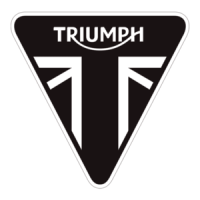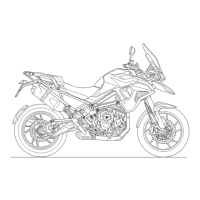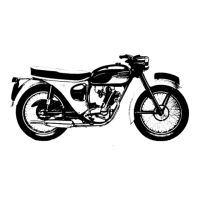Rocker ldjuster
Pin.
Slacken off the adjuster pin locknut and screw down
adjuster until
it
just contacts the valve tip.
For remaining details on models ST,
6T
and TI00 read (a) and (b) and for TI10 and TR5 read (a) and (c).
(a) When the adjuster contacts the valve tip, hold the adjuster firmly with the
spanner and tighten up the locknut with the other spanner. Grip the rocker
adjuster between thumb and forefinger and move the rocker sideways
to
test for freedom of movement. Now test the up and down movement where
the clearance between the adjuster and valve tip should be just perceptible.
(b) In order to obtain the 0.010" (0.26 mm.) clearance, first take particular note
of the squared end of the adjuster and with both spanners in position, slacken
the locknut slightly, taking care not to move the adjuster whilst doing so.
Now slacken off the adjuster
ONE
FLAT
(i
turn) and, maintaining
it
in the
new position, re-tighten the locknut.
Carry out the same procedure with each tappet.
(c) The clearance on the exhaust valve can be estimated by
first
adjusting the
tappet as in (a), paragraph (one). To obtain the 0.W4" (0.10 mm.) clearance,
slacken back the adjuster
HALF
A
FLAT
(+
turn). This may be slightly in
excess of the clearance figure but the error
is
on the right side. For the inlet
clearance, only slightly slacken off the adjuster so that when the rocker is
held between thumb and forefinger and operated in an up and down move-
ment, a distinct "click" can be hesrd when the adjuster strikes the valve tip.
The engine should be decarbonised only when
it
shows definite signs of requiring
this attention. Falling off in power, loss of compression, noisy operation, and more
difficult starting are all signs that the engine needs decarbonising. The engine will
probably run at least ten thousand miles (15,000
kms.) between the decarbonising
periods.
It
should be noted that
it
is
entirely unnecessary to remove the cylinder block
when decarbonising the engine. We strongly recommend that this part
is
not
taken
off
unless
it
is
proposed to
fit
new piston rings or do some other work on
the engine which necessitates the rem~val of the block. The engine wili run more
smoothly and give better service if the piston rings are left undisturbed.
Gasket sets are available for all models, and
it
is
recommended that the correct set
for the model
is
obtained before commencing the work.
Before commencing the operation, clean off any dirt, grease, etc., with paraffin or a
suitable degreasing agent. Secondly, obtain two boxes, one for the cylinder head,
etc., and the other for nuts, washers, etc. By doing this the operator
wili not have
to search rhe four corners of the garage for the vital nut to complete the job.

